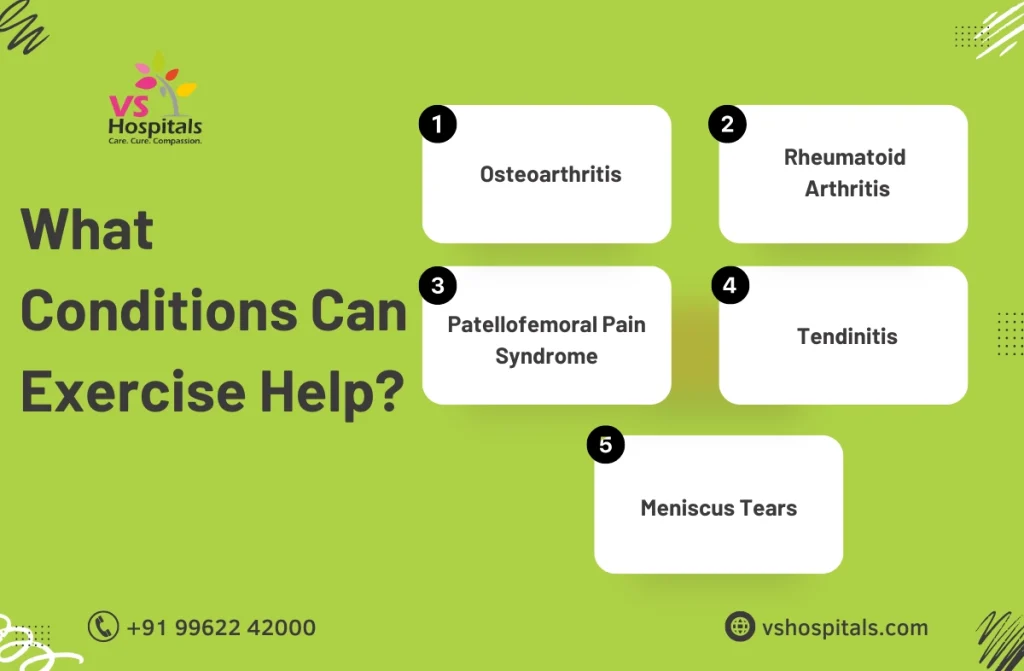Knee strengthening exercises for knee pain are essential for building stability, reducing discomfort, and promoting long-term joint health. These exercises work by targeting the muscles around the knee, providing the support needed for daily activities and reducing the strain on sensitive areas. Whether you’re recovering from an injury or aiming to prevent one, consistent knee-strengthening exercises can make a noticeable difference. With gentle, consistent movement, anyone—young adults to seniors—can improve knee function and enjoy a more active life.In cases where pain persists despite exercise, understanding the knee replacement surgery cost in Chennai may help individuals explore other treatment options with informed confidence.
Knee Strengthening Exercises for Knee Pain
Knee pain doesn’t always mean stopping activity—it often means modifying it. Whether you’re dealing with discomfort after long hours at a desk or recovering from an old sports injury, the right exercises can make a noticeable difference. These targeted movements not only help manage knee pain but also build stability and strength. They’re equally useful for young professionals and anyone seeking knee strengthening exercises for seniors in their family.
Straight Leg Raises
This exercise is a foundational move, especially when you’re just starting or trying to avoid weight-bearing exercises. It strengthens the quadriceps without putting pressure on the knee joint.
- Lie on your back with one leg bent and the other straight.
- Slowly raise the straight leg until it’s level with the bent knee.
- Keep the movement controlled and your abdominal muscles engaged.
- Lower the leg gently and repeat, switching sides after each set.
- Helps activate thigh muscles without irritating the knee joint.
Quad Sets
Quad sets are subtle but powerful, especially during recovery phases. They help re-engage the thigh muscles when full movement isn’t yet possible.
- Sit or lie down with legs extended on the floor.
- Tighten the thigh muscle of the affected leg by pressing the back of the knee down.
- Hold the contraction for 5–10 seconds, then relax.
- Repeat 10–15 times, focusing on controlled muscle engagement.
- Ideal for early-stage rehab and knee strengthening exercises for seniors.
Hamstring Curls
Hamstring curls improve balance between the front and back thigh muscles, offering joint support from all sides.
- Stand upright and hold onto a chair or wall for support.
- Bend one knee to lift your heel toward your buttocks.
- Avoid jerking; perform the movement slowly to feel the hamstring contract.
- Lower the leg gently and repeat before switching sides.
- Can be performed lying down if standing causes discomfort.
Step-Ups
Step-ups mirror real-life movements like climbing stairs. They’re excellent for building knee confidence and leg strength.
- Stand in front of a low step or platform.
- Step up with one foot, then bring the other foot up beside it.
- Step back down with the same leading foot, then alternate.
- Keep your posture upright and knees aligned over your toes.
- Builds strength in quads, glutes, and calves.
Wall Sits
This isometric hold builds both mental and muscular endurance. Wall sits challenge your lower body without requiring complex movement.
- Stand with your back against a wall and feet shoulder-width apart.
- Slide down into a seated position, keeping knees at 90 degrees.
- Hold the position for 10–30 seconds, working up to longer durations.
- Ensure your knees do not extend past your toes.
- Excellent for activating the quads and glutes in a static position.
Calf Raises
Although focused on the lower leg, calf raises are essential for stabilizing movements involving the knee and ankle.
- Stand tall and slowly raise your heels off the floor.
- Pause briefly at the top, then lower back down in control.
- Keep your body aligned and avoid swaying forward.
- Perform on both legs or progress to single-leg raises.
- Boosts ankle stability and supports dynamic knee control.
Clamshells
When hip muscles are weak, the knees often suffer. Clamshells target the glutes and outer thighs, reducing inward knee collapse.
- Lie on your side with knees bent and feet together.
- Keeping feet touching, lift the top knee without moving your hips.
- Pause at the top, then lower slowly.
- Focus on controlled motion rather than speed.
- Excellent for stabilizing the pelvis and improving knee alignment.
Side-Lying Leg Raises
These are perfect for isolating the hip abductors, which play a huge role in keeping the knee properly aligned during walking and running.
- Lie on one side with legs straight and stacked.
- Lift the top leg upward while keeping the body still.
- Keep toes pointing forward and avoid rotating the hip.
- Lower the leg gently and repeat.
- Helps prevent the knees from collapsing inward.
Glute Bridges
Strong glutes take pressure off the knees, and this move strengthens the posterior chain while also working the core.
- Lie on your back with knees bent and feet flat on the ground.
- Push through your heels to lift your hips up.
- Squeeze your glutes at the top and hold for a few seconds.
- Lower back down in control and repeat.
- Improves hip-knee coordination and supports posture.
Terminal Knee Extensions (TKEs)
TKEs are great for retraining the quadriceps and refining knee control, especially after injury or surgery.
- Attach a resistance band around a stable object and loop it behind your knee.
- Start with a slight bend in the knee, then straighten it fully against resistance.
- Hold briefly, then return to the starting position.
- Focus on smooth, deliberate motion.
- Useful in both rehabilitation settings and strengthening routines.

Seated Knee Extensions
- Sit upright in a chair with feet flat on the ground.
- Lift one foot until the leg is straight and parallel to the floor.
- Hold for a few seconds, then lower slowly.
- Alternate legs and aim for multiple reps.
- Can be progressed with ankle weights once strength improves.
A great desk-friendly option, seated knee extensions activate the quads without needing to stand or shift weight.
Standing Hip Abduction
This movement strengthens muscles around the hips that help stabilize your knees during lateral movement.
- Stand next to a wall or chair for support.
- Lift one leg out to the side while keeping your torso still.
- Avoid leaning or rotating your hip outward.
- Lower the leg with control and repeat on the other side.
- Builds pelvic stability and reduces strain on the inner knee.
Mini Squats
Mini squats are a gentler alternative to full squats, ideal when managing knee discomfort.
- Stand with feet shoulder-width apart.
- Lower your body slightly by bending the knees about 30–45 degrees.
- Keep your back straight and knees aligned over your feet.
- Return to standing, squeezing your glutes at the top.
- Activates the quads and glutes without overstressing the knees.
Resistance Band Leg Press
A low-impact yet effective way to simulate gym-style leg presses using just a resistance band.
- Sit on the floor with legs extended and loop a resistance band around your feet.
- Hold the ends of the band and push your feet forward until your legs are nearly straight.
- Slowly return to the starting position with control.
- Engages quads, hamstrings, and glutes.
- Excellent for home routines or knee strengthening exercises for seniors needing controlled resistance.
Heel and Toe Walks
This movement may seem simple, but it sharpens balance and coordination while subtly engaging the entire lower leg.
- Walk forward on your heels for a short distance, then switch and walk on your toes.
- Keep your knees straight but not locked.
- Focus on stability, not speed.
- Strengthens the shins, calves, and stabilizing muscles around the knees.
- Ideal as a warm-up or cool-down movement.
Importance of Post-Exercise Stretching
Post-exercise stretching is crucial after knee strengthening exercises for knee pain. Stretching helps ease muscle tension, enhances flexibility, and supports the recovery process, reducing the chance of injury or stiffness. Especially for knee strengthening exercises for seniors and those managing knee pain, post-exercise stretching is vital to maintain mobility.
- Quadricep Stretch: This stretch releases tension in the front thigh, promoting balanced knee support.
- Toe Touches: Effective for stretching hamstrings, which reduces strain on the knees.
- Standing Hamstring Stretch: Enhances flexibility in the back of the thigh, crucial for knee stability.
By incorporating these stretches, you’ll optimize the benefits of your knee muscle exercises, ensuring pain-free and effective movement.
How to Tell if You’re Exercising at the Right Level
The effectiveness of knee muscle exercises depends on finding the right level of intensity. Exercises should feel challenging but never painful. The key is to engage the muscles surrounding the knee without irritating the joint itself.
You’re likely at the correct level if:
- You feel muscle fatigue but no joint discomfort.
- There’s mild soreness the next day that quickly resolves.
- Movements are controlled and stable.
- Swelling does not increase after exercising.
- Range of motion continues to improve gradually.
If you experience sharp pain, a grinding sensation, or excessive stiffness, it’s time to reassess your routine.
When to Stop
Knowing when to stop is critical to prevent injury or setbacks. Knee exercises should strengthen, not aggravate the joint.
Stop your session immediately if:
- You feel sudden or sharp pain in the knee.
- Swelling increases noticeably during or after exercise.
- The knee feels unstable or gives way.
- You experience locking or restricted motion.
- There’s persistent discomfort despite correct technique.
Respecting these signals ensures that your routine remains safe and beneficial.
Benefits of Knee Strengthening Exercises for Knee Pain
Knee strengthening exercises for knee pain offer multiple benefits, helping individuals build resilience and improve overall mobility. These exercises not only target the muscles around the knee but also provide essential support to the joint, relieving pain and preventing further damage.
- Reduced Pain: By strengthening surrounding muscles, exercises lessen knee strain and discomfort.
- Enhanced Mobility: Improved muscle tone around the knee joint increases flexibility.
- Better Daily Function: Stronger knees mean easier movement in everyday activities.
Overall, knee muscle exercises, especially for knee strengthening exercises for seniors, can help maintain independence and keep knee pain under control, making daily life more comfortable and active.
Safety Considerations for Knee Strengthening Exercises
When performing knee strengthening exercises for knee pain, safety should always be a top priority. Whether you’re doing exercises for knee pain or focusing on knee muscle exercises for seniors, taking precautions ensures effective results and prevents further injury. Here are some essential safety tips:
- Consult Your Doctor: Always check with your healthcare provider before starting any new exercise routine, especially if you have a pre-existing knee condition.
- Start Slow: Gradually increase the intensity of exercises to avoid overloading your knees.
- Maintain Proper Form: Ensure correct posture and technique to prevent unnecessary strain.
- Warm-Up and Cool Down: Begin each session with a gentle warm-up and finish with stretching to protect the muscles and joints.
By following these guidelines, you can safely improve knee strength and reduce pain.
Conclusion
Knee strengthening exercises for knee pain can greatly improve your quality of life by reducing discomfort and supporting daily mobility. By regularly practicing these exercises, you build essential muscle strength around the knee, which helps alleviate pain and prevent further injury. From leg lifts to wall squats, these routines are accessible and effective for anyone, including seniors and those with exercises for knee pain. Incorporate these exercises into your routine for a stronger, healthier, pain-free life.
